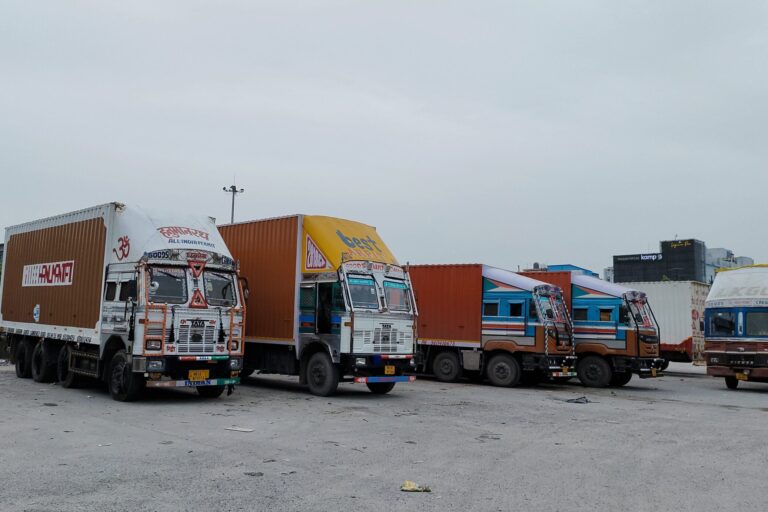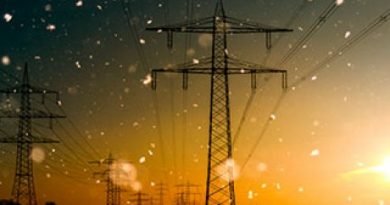On A Bumpy Road To Net Zero, Trucks Shift Gear To Reduce Emissions

- Diesel trucks that are the core of India’s domestic freight movement also contribute to the transport sector’s emissions.
- The move to zero-emission trucks could lead the way as India pushes to meet its 2070 net-zero targets.
- High upfront costs, clarity on charging infrastructure and effective communication with fleet owners in the primarily unorganised trucking sector are some of the challenges to overcome in the transitioning sector.
Anjar Ahmed, a truck driver in his fifties, recently embarked on a journey from Dispur in Assam to deliver tiles to Muzaffarpur, Bihar. Over the course of this trip, his 12-wheel truck guzzled approximately 250 litres of diesel, costing Rs. 23,000. The truck would have emitted around 670 kilograms of carbon dioxide on this journey, simply from burning the fuel. Based on these estimates, this single truck is projected to emit a total of 1,300 tonnes of CO2 over its operational lifespan.
India has approximately four million trucks (as of 2022), constituting the backbone of the country’s domestic freight movement. These trucks shoulder 70% of India’s freight demand, transporting over 4.6 billion tonnes annually. Despite comprising just 2% of the total vehicles on Indian roads, these freight trucks collectively contribute to 45% of the transport sector’s emissions.
As India undergoes a surge in urbanisation, population and e-commerce activities, an increase in road freight movement, is anticipated to cater to this escalating demand. A projected fleet of 17 million trucks is envisioned to be on Indian roads by 2050.
In this scenario, a move to zero-emission trucks – electric trucks that have negligible carbon emissions as they ply – could lead the way as India pushes to meet its 2070 net-zero targets. In India, zero emissions truck is currently at the concept stage, with a few pilot vehicles developed by private organisations, in operation, notes the government’s roadmap for deploying ZETs in India, released earlier this year. While the relevant technical capability and supply chain options are available, more work is needed to develop the ecosystem and products.

Amit Bhatt, Managing Director for India at the International Council on Clean Transportation (ICCT), says, “We have committed to going to [net] zero by 2070. To achieve that, we have to make our transport net-zero,” he asserts. Almost all the emissions from the transportation sector — 90% — is from road transport, with trucks accounting for approximately 50% of these emissions, he shares.
Bhatt explains that while advancements in enhancing the efficiency of internal combustion engines are feasible, they alone cannot meet climate targets. “The only way forward is ZET or Zero-Emission Trucks,” he tells Mongabay India. This means, the solution will come through battery-electric or hydrogen fuel cell technologies, he says. While hydrogen infrastructure remains under development, battery technologies for ZETs are already operational and primed for uptake.
Echoing this sentiment, a 2022 NITI Aayog emphasises the transformative potential of ZETs. It states, “A determined transition to ZETs can lead to 2.8-3.8 gigatonnes of cumulative CO2 savings through 2050, which is equal to or greater than India’s entire economy-wide annual GHG emissions today.”

Electric trucks to support energy transition
Amid India’s G20 presidency, a surge of activity in support of ZETs is taking place. In July this year, fifteen companies joined forces to spearhead the electrification of India’s truck market. These companies will operate under the Zero Emission Vehicles Emerging Markets Initiative (ZEV-EMI) and in collaboration with the Indian government’s E-FAST (Electric Freight Accelerator for Sustainable Transport) initiative. They unveiled several pilot projects during the fourth Energy Transitions Working Group meeting in Goa in July this year. They project that there will be a demand for 7,700 e-trucks in India by 2030.
Concurrently, during the G20 Energy Ministers’ meeting, the World Economic Forum announced the launch of India’s pioneering zero-emission road freight cluster initiative. In partnership with the Ministry of Ports, Shipping and Waterways and supported by NITI Aayog’s e-FAST program, this initiative aims to deploy 550 ZETs within the next 18-24 months, along select road corridors in Gujarat and Maharashtra.
Jasmeet Khurana, Lead of Moving Emerging Markets at the World Economic Forum, elucidates the purpose behind India’s inaugural zero-emission road freight cluster. He states, “Through India’s first zero-emission road freight cluster, we aim to establish a model where a few hundred zero-emission trucks operate. This will create a network effect, prompting other shippers to consider transitioning to zero-emission. Given the necessity of establishing charging and servicing infrastructure, a concentrated approach within specific geographic regions appears more logical than scattering efforts across the nation.”

Khurana emphasises the need to demonstrate the viability of ZETs for widespread adoption. “Creating proof of concepts is essential to showcase the feasibility of adopting this technology today and its scalability in the future,” he adds.
On a global scale, India is poised to become the world’s second-largest trucking market in the next decade. This underscores the significance of India’s endeavours to decarbonise global trucking. The World Economic Forum’s engagement in this field highlights the potential to contribute further to global decarbonisation through the Zero-Emission Truck initiative in India, he adds.
Beyond these initiatives, the government has also released several reports. The Office of the Principal Scientific Adviser to the Government of India published a report in March outlining the technical roadmap for ZET deployment in India. A G20 secretariat task force released a report exploring the prospects of promoting ZETs across developing nations. In 2022, NITI Aayog, in collaboration with RMI, an independent non-profit organisation, published a report titled Transforming Trucking in India: Pathways to Zero-Emission Truck Deployment which delves into the potential transition of the existing fleet of diesel-powered trucks to electric or hydrogen-powered alternatives.
Two prominent Indian truck manufacturers, Tata Motors and Ashok Leyland, have taken initial strides toward ZET adoption. Tata Motors, dominating nearly 50% of India’s truck sales market, has committed, in its latest annual report, to achieving net-zero emissions for its commercial vehicles by 2045. This commitment means that all trucks sold by Tata Motors in 2045 will be ZETs, a notable advancement, as explained by an industry expert.

Upfront costs, charging infrastructure
Anjar Ahmed recalls a day while returning from Assam when the truck he was driving went out of fuel. “We parked the truck at the roadside and went to buy fuel in a bucket. We travelled a few kilometres and managed to get some. After refilling the bucket of fuel, we took the truck to the fuel pump. We called the truck owner and he paid the fuel charge to the pump owner directly,” he chuckled while sharing his experience. Life on the Indian road is a world of its own, he asserts.
Using this example, Ahmed emphasises the fact that while India has fuel stations at short distances, challenges still persist. “We face such hurdles. I don’t know what the logistics of electric trucks and charging facilities will be like.”
Experts say that adopting zero-emission trucks will be a challenging task for India’s fragmented yet critical market. The first challenge is the upfront cost. According to a NITI Aayog report, ZETs currently have a higher upfront cost than diesel trucks and are not widely manufactured or available in India. The cost difference can be around twice as much for medium-duty trucks (MDTs) and over six times for heavy-duty trucks (HDTs).
When asked about the steep upfront cost of ZETs compared to diesel-based trucks, Amit Bhatt explains that the cost disparity in India is relatively high compared to countries such China, Europe, or the USA. Indian trucks, in general, are lighter and smaller than their global counterparts, making them more affordable in India.

Highlighting the potential challenges in adopting ZETs, Bhatt points out that the overall upfront cost presents a significant hurdle. Currently, trucks are not included in any demand incentive schemes, whether it’s the Faster Adoption and Manufacturing of Electric Vehicles (FAME) subsidy— a scheme that provides incentives to buyers of electric vehicles — or state-level EV policies. This lack of financial incentives for trucks presents an additional challenge.
Bhatt also highlights infrastructure issues, emphasising the need for high-capacity charging infrastructure for trucks. Referring to the proposed cluster-level development in Gujarat and Maharashtra, Jasmeet Khurana explains that even for the government to gain confidence and support the sector, proof of concept is essential and that’s what they are striving to establish with anchor companies. Once the government sees the benefits, policy intervention will follow.
Khurana points out another challenge. “India’s trucking market remains largely unorganised at present. Thus, the pivotal task lies in persuading numerous small fleet owners to embrace zero-emission trucks.”
According to Khurana, the significant challenge lies in imparting clarity and effective communication to these fleet operators. “While global efforts are underway to refine technology and other aspects, the crucial question is how to seamlessly integrate these technologies in a financially viable way for Indian fleet owners. Convincing them to transition to zero-emission trucking is where the greatest hurdle lies,” he explains.

Significant preparatory and technical work is necessary to successfully pilot and ramp up Battery Electric Trucks (BET) and ZETs in the field. These activities will demand meticulous planning, financial support, workforce backing, and collaboration with multiple stakeholders, as concluded in the report published by the Office of the Principal Scientific Adviser to the Government of India.
When informed about the multitude of developments related to ZETs in policy forums, Ahmed’s curiosity is piqued. When asked about his sentiments, he expresses while enjoying kachori in his truck cabin parked in Noida, “We’ll be able to share our experience once we get a chance to drive these zero-emission trucks.”
Banner image: India is poised to become the world’s second-largest trucking market in the next decade. Photo by Vinayaraj/Wikimedia Commons.
This story was first published on Mongabay India. It is republished here with permission.




